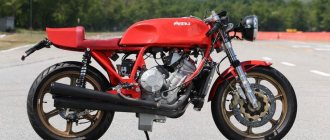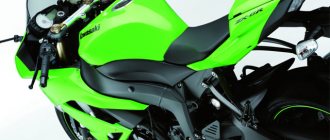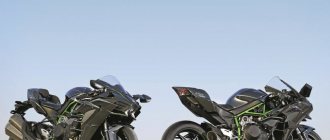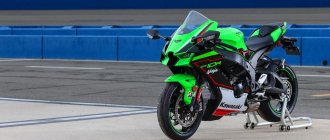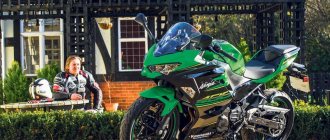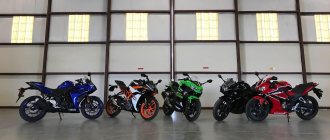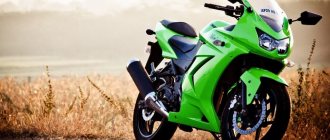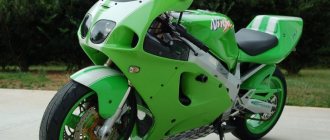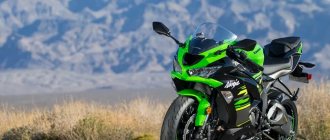RU-MOTO rating
- Reliability
- Chassis
- Appearance
- Comfort
5
Verdict
To sum it up, it's hard to say for sure what this bike is like. We are designed in such a way that it is difficult for us to accept new things. Time will pass, and we will definitely taste this “fruit” and learn all its strengths and weaknesses over time. But one thing is for sure: this is not a motorcycle that will go unnoticed. The company managed to create something that truly excited the tech community.
Motorcycle Kawasaki Ninja H2R
We have all been familiar with the model of a typical Japanese sportbike for a long time. Liter inline four, but there’s nothing to add here. It seemed like what could be better? And the sound...mmm? This is music to a motorcyclist's ears. What about reliability? After all, this is a technology that has been proven for years. Justified conservatism, you say? Maybe. But Kawasaki certainly doesn’t think so. Therefore, they presented us with their new monster - Kawasaki H2R.
Read other motorcycle reviews of the Yamaha YBR-125 - is it really the best small-capacity motorcycle?
Release Features H2R Line
The release of the model continues.
The Kawasaki Ninja H2R is a track-only racing version that produces 310 hp.
Moreover, new modifications of the bike begin to be developed two years after sales. In addition to the details inherent in any sport, the line is immediately distinguished by two key features:
- , a supercharging system appears on a serially sold motorcycle ;
- the speed of the new bike exceeds 300 km/h .
Note that the Yamaxa VMAX, with characteristic additional pipes on the sides of the fuel tank, even in the premium configuration, does not use them for supercharging, and in addition, its speed is electronically cut at around 220 km/h .
Kawasaki, sold all over the world, has no jammers and officially considered the fastest motorcycle in the world .
But you also need to pay attention that the H2R is a purely racing motorcycle, therefore it does not have mirrors and most lighting devices . In addition, there is no title - and therefore, it is impossible to register it, and the appearance of it on public roads will certainly interest traffic police inspectors.
Specifications
Engine – right side view.
Engine – left view.
Pressure pipe.
Steel frame.
The key feature of a bike engine is supercharging. It uses a two-speed centrifugal supercharger. Additionally, a lattice frame design is used to better dissipate heat from the engine. Apart from this, the engine of the motorcycle is ordinary, 4-stroke, with 4 cylinders arranged in a row:
- working volume - 988 cm3;
- number of cylinders - 4;
- number of cycles - 4;
- number of valves - 16, 4 per cylinder;
- power - 200 (310) hp;
- torque - 133.5 (165) Nm;
- cooling - liquid;
- fuel supply - injector 4x double injector system, 50 mm;
- ignition - digital;
- start - electric starter;
- tank volume - 17 l.
The strict assignment of one of the modifications only to tracks should have affected the power and torque settings. Its indicators are in brackets.
Transmission and clutch
The motorcycle engine is equipped with a 6-speed gearbox. Even before production began, the gearbox was rebuilt, the gear ratios were scattered across the entire speed range, and the foot stroke was reduced.
Control foot for 6-speed gearbox.
The bike has a quick shifter and a slipper clutch . Despite the stress that he may experience during his racing career, no special reinforcements were made. All according to standards:
- Multi-disc , oil bath clutch. Power transmission is a cable .
- Main drive - chain.
Classic chain drive.
Brakes
Supercharging and guaranteed 300 km/h require a good braking system. But it differs only slightly from the standards, with the exception of the use of Brembo .
Front brakes.
Rear brakes.
Front brakes
- number of disks - 2;
- diameter - 320 mm;
- support - 4-piston.
Rear brakes
- number of disks - 1;
- diameter - 250 mm;
- support - 2-piston.
In addition to stock ABS, additional braking assistance is provided by the KIBS - the brand’s own development specifically for this bike (deciphered in the features).
Maximum speed of H2R[edit]
James Hiller's H2R (Quattro Plant/Bournemouth Kawasaki) [18] Tire heaters were electrically heated prior to demo run [19]
2015[edit]
In June 2015, TT race competitor James Hillier rode a Kawasaki H2G as a demo lap between the race at near-racing speeds, [18] using regular Superbike slippery racing tires, [19] on a 37 3/4-mile road course, which resulted in setting the TT record for fastest top speed achieved by a motorcycle on the Isle of Man. [20] Top speeds of "over 206 mph" (332 km/h) on the Sulby Straight were recorded in the Strava GPS personal smartphone app for cyclists. [21]
2016[edit]
On June 30, 2016, five-time Supersport circuit racing world champion Kenan Sofuoğlu attempted top speed. [22] [23] Kawasaki supplied spare H2R, different specially formulated rubber tires developed by Pirelli for top speed and withstanding extreme high speeds, and the motorcycle was supplied with racing grade fuel. [24] Sofuoğlu was fitted with a special one-piece leather suit to improve aerodynamics during his record attempt. [24]
This attempt, involving the Turkish President, was made across the newly built Osman Ghazi Bridge, the fourth longest in the world at just over one and a half miles long. [25] Kawasaki indicated the H2R's top speed to be 380 kilometers per hour (240 mph). [26] After four months of training and preparation, video from the motorcycle's dashboard display claimed a speed of 400 kilometers per hour (250 mph) in just 26 seconds. [8] [27] [28] [29]
The speed has not been officially confirmed or verified by independent organizations. No fixed-point optical sensors were used to calculate distance/speed, chronometers or handheld devices [7], and later with a theoretical calculation [30] of the distance he covered in 26 seconds on the 8,799-foot-long (2,682 m) bridge. World' cycle
s Kevin Cameron calculated two years earlier that with right-hand gearing, the H2ge's engine power could theoretically overcome aerodynamic drag of up to 250-260 mph (400-420 km/h). [31]
Driving performance
Even the so-called “civilian” version of the H2 has a top speed of 337 km/h . According to some sources, the speed of the racing modification can reach 350 km/h . The amount of electronics packed into the motorcycle, as well as a well-tuned box, make it possible to achieve these values easily and naturally. The bike accelerates smoothly throughout the entire range.
Acceleration to hundreds
Acceleration from a standstill to 100 km/h is also capable of pleasing the average user. For the civilian modification it is stated - 2.5 seconds .
Fuel consumption
A user who wants such a motorcycle will be pleasantly surprised. The fuel consumption of this monster is only 5 (five!!!) liters per 100 km .
CONTENT
- 1 H2R top speed 1.1 2015
- 1,2 2016
- 2.1 Speed record
- 3.1 Engine and supercharger
- 5.1 Reactions
- 7.1 Notes
Dimensions and weight
The lightest is the racing version; civilian versions have a higher curb weight.
Since the model is constantly updated, the external parameters and weight of the motorcycle vary quite widely.
curb weight for:
- Ninja H2 - 238 kg ;
- Ninja H2R - 216 kg ;
- Ninja H2 SX - 256 kg ;
- Ninja H2 SX SE - 260 kg ;
- Ninja H2 Carbon - depends on the version.
The overall dimensions of the line do not go beyond standard sports.
- in length - 2,085 (2,070 mm);
- width - 770 mm;
- in height - 1,125 (1,160) mm.
- Seat height—825 (830) mm.
- Wheelbase - 1,455 (1,450) mm.
- Ground clearance - 130 mm.
The H2R version is a little different. Its parameters are given in parentheses.
For whom is it intended?
As the developer states, the bike has no special divisions into sales markets.
First of all, the bike is intended for those who are ready to pay a decent amount for it - the most budget model “starts” at $19,000, and the cost of the H2R version reaches $50,000.
In fact, only civilian modifications reach domestic markets. But regardless of the modification, the geometry of the motorcycle is designed for a person of average and tall height. It is recommended that short people choose another option.
Production announcement[edit]
At the Intermot motorcycle show on September 30, 2014, Kawasaki announced that a race-only Ninja H2R model would be released, in addition to the street-legal lower power Ninja H2, which would be on full display at the EICMA show in November. [50] [15] The bike was first shown in North America at AIMExpo in Orlando, Florida in October 2014. [67]
Kawasaki released some details about the Kawasaki H2 engine at Intermot. It was confirmed to be a 998cc inline-four engine. A supercharged CM producing 300 horsepower (220 kW) in the race-only H2R variant, which is still the most powerful engine of any factory motorcycle.[50][48]. ] [49] 50% more than its closest competitor, the BMW S1000RR. [15]
Reactions[edit]
Global press coverage both before and after Intermot was extensive.
Prior to the full reveal of the H2R, reactions tended to highlight the return of forced induction to the motorcycle market, with headlines like "Hail to the New Era of Supercharged Engines" (AutoEvolution), [48] "A Supercharged Ninja Is Inevitable" ( Motor Cycle News
(UK)), [10] “Kawasaki's new sports bike will use a 1000cc supercharged engine.
See" (Wisordown (UK)), 2014 "Kawasaki officially unveils the Ninja H2 supercharger" ( Cycle Online
(Australia)), [9] "Kawasaki Ninja H2: How the supercharger works" (
Motociclismo
(Italy)), [13] and " Kawasaki H2 Superbike: A Technical Look at Kawasaki's Upcoming Supercharged Superbike" (
Cycle World
(USA)). [17]
Following the presentation, before any test rides were allowed, coverage turned to both the bike's unusual styling and its precedent-setting power. Both the industry and general press said that the car would "beat the supersport scene with a steam hammer" ( Der Tagesspiegel
) [68], "will crush the superbike class" (Gizmag), [49] "game changer" (Autoevolution) [69] "a quantum leap into a future that redefines the way we see motorcycles" (Independent Newspapers), [59] ] and "an example of two-wheeled madness... so extreme it's hard to comprehend" (
Road & Track
), [70] or simply "radical" (
Motor Cycle News
) [15] and even "ridiculous" (
Bloomberg Businessweek
). [56]
Cycle World
and
Motor Cycle News
commented on how Kawasaki was targeting the top end of the market with the H2, moving past a stagnant market (at least from the Big Four Japanese manufacturers) full of cookie-cutter sportbikes and low-cost entry-level cars.
motorcycles, and made the H2 a halo model for the entire brand. Kevin Cameron of Cycle World said: "When we look at the current crop of thousands of examples, they all date from before our current 'recession' and what little has emerged from the new product has sought to please a largely imaginary 'new buyer' with a low price." technical delights." [31] Highlighting Kawasaki's ability to create a product with improved aerodynamics, turbine and engine design expertise from all angles of the Kawasaki Heavy Industries conglomerate (called a Sport Rider
[52]), an unsigned
Motor Cycle News
states: "The H2R you see here is the pinnacle of what Kawasaki can do... This is the halo of the company. product, and every element of it is the best of Kawasaki, from the engine and aerodynamic enhancements to the mirror black chrome paint specially designed for this model.” [15]
Some analysts have noted the strange features of the supposedly track-only H2R model. While it is fitted with racing slicks and lacks many of the features required of street vehicles in most jurisdictions, such as headlights, rearview mirrors and turn signals visible from the front or side, it also has features that are unusual or missing on pure track bikes. such as the ignition switch and LED tail lights. [15] [58]
Unless otherwise noted, the specifications in the information box are those of Kawasaki. [71]
Modifications and competitors
Over the course of several years of production, the bike managed to acquire five modifications.
- Kawasaki Ninja H2 — the civilian version, with which the development of the line begins.
The civilian version has mirrors with turn signals.
And you can even install side panniers.
- Kawasaki Ninja H2R is a parallel racing development. It differs from the first redesigned exhaust system, different boost settings, as well as overall dimensions and ergonomics. Additionally, the gearbox has been reconfigured and a special preparation package for track use has been applied.
- Kawasaki Ninja H2 SX - starts from 2018. The budget modification is distinguished by engine settings, installation of cheaper components (in particular, no Brembo), and changes in the settings of all systems. It’s interesting that the budget version will have a more capacious fuel tank - 19 l.
The Ninja H2 SX version is available with three engine options - 150, 170 or 200 l/s, depending on the region of sale.
- Kawasaki Ninja H2 SX SE - also launches in 2018. It is an expanded version of the previous modification, as evidenced by the additional letters (SE - Special Edition).
Receives seven additional solutions:
- LED optics;
- color instrument panel (screen);
- KLSM;
- KQS;
- heated handles;
- large windshield;
- the double saddle becomes more comfortable.
Kawasaki Ninja H2 Carbon
A limited version will be released in 2022, only 120 copies.
The Kawasaki Ninja H2 Carbon modification features a carbon fiber fairing and a special silver-mirror color scheme.
Models are numbered, their own number is indicated on the supercharger. It is distinguished by a different front fairing, an enlarged opening for cold air intake, which embraces the headlight, other mirrors and additional aerodynamic slits on the body. The backlighting of the tidy has been changed - 4 options , which are selected using the buttons next to it, there is an “ AUTO ” mode. It allows you to adjust the brightness depending on the surrounding conditions.
Based on the filling, developed power and speed, the bike does not have any significant competitors.
Announcements and analysis of the Pre-Intermot engine[edit]
Engine shown at the 2013 Tokyo Motor Show, with "Kawasaki" embossed on the supercharger cover to the right of the cylinders
Kawasaki previewed the H2 in a teaser campaign in late 2014, and many expected it to be fully unveiled at Intermot that year. Before Kawasaki released full details, the supercharged inline-four [60] engine was considered by some industry observers to be identical to or closely related to the nearly 1000 cc inline-four engine. See with the centrifugal supercharger presented by Kawasaki at the exhibition. Tokyo Motor Show 2013. [11] [61] Kevin Cameron published an analysis showing that an engine with this displacement, slightly boosted to 5 psi (34 kPa), would generate 203 horsepower (151 kW), more than current leader Kawasaki. 191.7 horsepower (143.0 kW)) [62] ZX-14 (power figures shown at rear wheel).
The same engine will generate 257 horsepower (192 kW) at 10 psi (69 kPa). His analysis included a discussion of the benefits of a two-speed supercharger for this application to provide more linear power delivery (unlike the hard-to-handle Japanese turbo bikes of the 1980s, which suffered from turbo lag). Cameron also said that Kawasaki's patent documents suggest the engine will rely on evaporative cooling, using port fuel injection instead of a bulky intercooler. [17] Kawasaki stated that the 2013 model was the first supercharger developed by a motorcycle manufacturer.
[63] In 2013, journalists stated that this engine could be installed in the "next generation [Ninja] ZX-14R" sportbike. [64] Journalists also noted that Kawasaki already had a production supercharged (but intercooled [65]) four-cylinder engine powering the Jet Ski Ultra 300X watercraft. [66]
Flaws
Since the bike is new, there is no need to talk about shortcomings yet. There are some complaints about the fit and the angle of the control feet.
and dignity
The advantages include:
- chic appearance;
- good instrument panel;
The instrument panel is made in the form of a dual unit, consisting of a dial tachometer and a digital speedometer.
- controllability.
Speed is not mentioned, but the fact that even a non-racing version can reach over 300 km is worthy of respect.
Performance characteristics of Kawasaki Ninja H2 Stage 2
Stage 2 Kit Engine Components Exhaust System: New Brock's Performance Modular Exhaust System Fuel Delivery: Dynojet PCV with Brock's Performance Ohio Mile Custom Tuning ECU: Brock's Stage 2 ECU Flash Clutch Kit: Brock's Performance Clutch Mod Air Filter: Stock Airbox Filter Engine Oil : synthetic oil Alisyn Pro Drive 21 Race Series, 10w - 30 Oil additive: Petron Plus Formula 7 Racing fuel: VP Racing, leaded and oxygenated Stage 2 kit (chassis) Front sprocket: 19 teeth Rear sprocket: 41 teeth Lowered front end : Brock's Performance Radial Mount Lowering Kit
